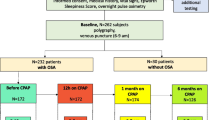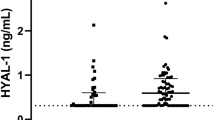Abstract
Purpose
Microvesicles (MVs) have been implicated in the pathomechanism of obstructive sleep apnoea (OSA); however, the results are inconsistent, possibly due to an unrevealed temporal variation in circulating MV levels. We aimed to investigate the diurnal changes of MV fractions in OSA.
Methods
Peripheral blood was taken from 18 patients with OSA and 9 healthy subjects at different time points (11:00, 17:00, 21:00, 01:30 and 06:00). Samplings were repeated in nine OSA patients after 2 months of continuous positive airway pressure (CPAP) therapy. CD41+, CD62P+, glycophorin A+ and Annexin V+ MVs were determined with flow cytometry. Areas under the MV concentrations-time curves (AUC) were calculated and correlated with the severity of OSA.
Results
A significant diurnal variability of plasma CD41+ and Annexin V+ MVs was observed only in OSA with a marked peak at 17:00. There was a direct correlation between CD41+ MV AUCs and the severity of OSA. CPAP treatment reduced diurnal variability in both CD41+ and Annexin V+ MV levels.
Conclusions
The relationship between the diurnal variability of CD41+ MVs and disease severity as well as the effect of CPAP treatment on MV levels support the role of MVs in the pathophysiology of OSA. More importantly, considering the significant diurnal variation in circulating MV levels, introduction of strict protocols for blood sampling is required for MV measurements.




Similar content being viewed by others
References
Gyorgy B, Szabo TG, Pasztoi M, Pal Z, Misjak P, Aradi B, Laszlo V, Pallinger E, Pap E, Kittel A, Nagy G, Falus A, Buzas EI (2011) Membrane vesicles, current state-of-the-art: emerging role of extracellular vesicles. Cellular and molecular life sciences : CMLS 68(16):2667–2688. doi:10.1007/s00018-011-0689-3
Jelic S, Lederer DJ, Adams T, Padeletti M, Colombo PC, Factor P, Le Jemtel TH (2009) Endothelial repair capacity and apoptosis are inversely related in obstructive sleep apnea. Vasc Health Risk Manag 5:909–920
Maruyama K, Morishita E, Sekiya A, Omote M, Kadono T, Asakura H, Hashimoto M, Kobayashi M, Nakatsumi Y, Takada S, Ohtake S (2012) Plasma levels of platelet-derived microparticles in patients with obstructive sleep apnea syndrome. J Atheroscler Thromb 19(1):98–104
Tual-Chalot S, Gagnadoux F, Trzepizur W, Priou P, Andriantsitohaina R, Martinez MC (2014) Circulating microparticles from obstructive sleep apnea syndrome patients induce endothelin-mediated angiogenesis. Biochim Biophys Acta 1842(2):202–207. doi:10.1016/j.bbadis.2013.11.017
Szabo GT, Tarr B, Paloczi K, Eder K, Lajko E, Kittel A, Toth S, Gyorgy B, Pasztoi M, Nemeth A, Osteikoetxea X, Pallinger E, Falus A, Szabo-Taylor K, Buzas EI (2014) Critical role of extracellular vesicles in modulating the cellular effects of cytokines. Cellular and molecular life sciences : CMLS. doi:10.1007/s00018-014-1618-z
Raposo G, Nijman HW, Stoorvogel W, Liejendekker R, Harding CV, Melief CJ, Geuze HJ (1996) B lymphocytes secrete antigen-presenting vesicles. J Exp Med 183(3):1161–1172
Diamant M, Nieuwland R, Pablo RF, Sturk A, Smit JW, Radder JK (2002) Elevated numbers of tissue-factor exposing microparticles correlate with components of the metabolic syndrome in uncomplicated type 2 diabetes mellitus. Circulation 106(19):2442–2447
Yun CH, Jung KH, Chu K, Kim SH, Ji KH, Park HK, Kim HC, Lee ST, Lee SK, Roh JK (2010) Increased circulating endothelial microparticles and carotid atherosclerosis in obstructive sleep apnea. Journal of clinical neurology (Seoul, Korea) 6(2):89–98. doi:10.3988/jcn.2010.6.2.89
Trzepizur W, Martinez MC, Priou P, Andriantsitohaina R, Gagnadoux F (2014) Microparticles and vascular dysfunction in obstructive sleep apnoea. The European respiratory journal. doi:10.1183/09031936.00197413
Ayers L, Ferry B, Craig S, Nicoll D, Stradling JR, Kohler M (2009) Circulating cell-derived microparticles in patients with minimally symptomatic obstructive sleep apnoea. The European respiratory journal 33(3):574–580. doi:10.1183/09031936.00107408
Kim J, Bhattacharjee R, Kheirandish-Gozal L, Spruyt K, Gozal D (2011) Circulating microparticles in children with sleep disordered breathing. Chest 140(2):408–417. doi:10.1378/chest.10-2161
Geiser T, Buck F, Meyer BJ, Bassetti C, Haeberli A, Gugger M (2002) In vivo platelet activation is increased during sleep in patients with obstructive sleep apnea syndrome. Respiration; international review of thoracic diseases 69(3):229–234 doi:63625
Priou P, Gagnadoux F, Tesse A, Mastronardi ML, Agouni A, Meslier N, Racineux JL, Martinez MC, Trzepizur W, Andriantsitohaina R (2010) Endothelial dysfunction and circulating microparticles from patients with obstructive sleep apnea. Am J Pathol 177(2):974–983. doi:10.2353/ajpath.2010.091252
Akinnusi ME, El Solh AA (2009) Circulating endothelial microparticle levels and hemodynamic severity of pulmonary hypertension: is there a role for sleep apnea? Am J Respir Crit Care Med 179(4):328 . doi:10.1164/ajrccm.179.4.328aauthor reply 328-329
Kunos L, Bikov A, Lazar Z, Korosi BZ, Benedek P, Losonczy G, Horvath I (2014) Evening and morning exhaled volatile compound patterns are different in obstructive sleep apnoea assessed with electronic nose. Sleep & breathing = Schlaf & Atmung. doi:10.1007/s11325-014-1003-z
Vgontzas AN, Bixler EO, Lin HM, Prolo P, Trakada G, Chrousos GP (2005) IL-6 and its circadian secretion in humans. Neuroimmunomodulation 12(3):131–140. doi:10.1159/000084844
Jordan W, Reinbacher A, Cohrs S, Grunewald RW, Mayer G, Ruther E, Rodenbeck A (2005) Obstructive sleep apnea: plasma endothelin-1 precursor but not endothelin-1 levels are elevated and decline with nasal continuous positive airway pressure. Peptides 26(9):1654–1660. doi:10.1016/j.peptides.2005.02.012
Trzepizur W, Priou P, Paris A, Nardi J, Tual-Chalot S, Meslier N, Urban T, Andriantsitohaina R, Martinez MC, Gagnadoux F (2011) Nocturnal release of leukocyte-derived microparticles in males with obstructive sleep apnoea. The European respiratory journal 37(5):1293–1295. doi:10.1183/09031936.00150010
Kushida CA, Littner MR, Morgenthaler T, Alessi CA, Bailey D, Coleman J Jr, Friedman L, Hirshkowitz M, Kapen S, Kramer M, Lee-Chiong T, Loube DL, Owens J, Pancer JP, Wise M (2005) Practice parameters for the indications for polysomnography and related procedures: an update for 2005. Sleep 28(4):499–521
Pap E, Pallinger E, Falus A, Kiss AA, Kittel A, Kovacs P, Buzas EI (2008) T lymphocytes are targets for platelet- and trophoblast-derived microvesicles during pregnancy. Placenta 29(9):826–832. doi:10.1016/j.placenta.2008.06.006
Faul F, Erdfelder E, Buchner A, Lang AG (2009) Statistical power analyses using G*power 3.1: tests for correlation and regression analyses. Behav Res Methods 41(4):1149–1160. doi:10.3758/brm.41.4.1149
van der Zee PM, Biro E, Ko Y, de Winter RJ, Hack CE, Sturk A, Nieuwland R (2006) P-selectin- and CD63-exposing platelet microparticles reflect platelet activation in peripheral arterial disease and myocardial infarction. Clin Chem 52(4):657–664. doi:10.1373/clinchem.2005.057414
Barcelo A, Pierola J, de la Pena M, Frontera G, Yanez A, Alonso-Fernandez A, Ayllon O, Agusti AG (2012) Impaired circadian variation of platelet activity in patients with sleep apnea. Sleep & breathing = Schlaf & Atmung 16(2):355–360. doi:10.1007/s11325-011-0501-5
Ayers L, Stoewhas AC, Ferry B, Stradling J, Kohler M (2013) Elevated levels of endothelial cell-derived microparticles following short-term withdrawal of continuous positive airway pressure in patients with obstructive sleep apnea: data from a randomized controlled trial. Respiration; international review of thoracic diseases 85(6):478–485. doi:10.1159/000342877
Kafian S, Mobarrez F, Wallen H, Samad B (2015) Association between platelet reactivity and circulating platelet-derived microvesicles in patients with acute coronary syndrome. Platelets 26(5):467–473. doi:10.3109/09537104.2014.940304
Mallat Z, Benamer H, Hugel B, Benessiano J, Steg PG, Freyssinet JM, Tedgui A (2000) Elevated levels of shed membrane microparticles with procoagulant potential in the peripheral circulating blood of patients with acute coronary syndromes. Circulation 101(8):841–843
Werner N, Wassmann S, Ahlers P, Kosiol S, Nickenig G (2006) Circulating CD31+/annexin V+ apoptotic microparticles correlate with coronary endothelial function in patients with coronary artery disease. Arterioscler Thromb Vasc Biol 26(1):112–116. doi:10.1161/01.atv.0000191634.13057.15
Livaja Koshiar R, Somajo S, Norstrom E, Dahlback B (2014) Erythrocyte-derived microparticles supporting activated protein C-mediated regulation of blood coagulation. PLoS One 9(8):e104200. doi:10.1371/journal.pone.0104200
Manfredini R, Boari B, Smolensky MH, Salmi R, la Cecilia O, Maria Malagoni A, Haus E, Manfredini F (2005) Circadian variation in stroke onset: identical temporal pattern in ischemic and hemorrhagic events. Chronobiol Int 22(3):417–453. doi:10.1081/cbi-200062927
Haus E, Cusulos M, Sackett-Lundeen L, Swoyer J (1990) Circadian variations in blood coagulation parameters, alpha-antitrypsin antigen and platelet aggregation and retention in clinically healthy subjects. Chronobiol Int 7(3):203–216
Acknowledgements
The study was supported by Hungarian Respiratory Society (grants to Andras Bikov and Zsolt I. Komlosi) as well as Hungarian Scientific Research Fund (OTKA 68758, 109008). The authors are also grateful to Elektro-Oxigén Inc. for providing the polysomnographic devices. This publication was supported by the Janos Bolyai Research Scholarship of the Hungarian Academy of Sciences to Andras Bikov. The authors are extremely grateful to Mrs. Monika Banlaky for her technical assistance with PSG.
Author information
Authors and Affiliations
Corresponding author
Ethics declarations
Funding
Hungarian Respiratory Society (grants to Andras Bikov and Zsolt I. Komlosi) as well as Hungarian Scientific Research Fund (OTKA 68758, 109008) provided financial support in the form of funding to buy materials and reagents for experiments. The sponsor had no role in the design or conduct of this research.
Conflict of interest
The authors declare that they have no conflict of interest.
Ethical approval
All procedures performed in studies involving human participants were in accordance with the ethical standards of the institutional and/or national research committee and with the 1964 Helsinki Declaration and its later amendments or comparable ethical standards.
Informed consent
Informed consent was obtained from all individual participants included in the study.
Rights and permissions
About this article
Cite this article
Bikov, A., Kunos, L., Pállinger, É. et al. Diurnal variation of circulating microvesicles is associated with the severity of obstructive sleep apnoea. Sleep Breath 21, 595–600 (2017). https://doi.org/10.1007/s11325-017-1464-y
Received:
Accepted:
Published:
Issue Date:
DOI: https://doi.org/10.1007/s11325-017-1464-y




